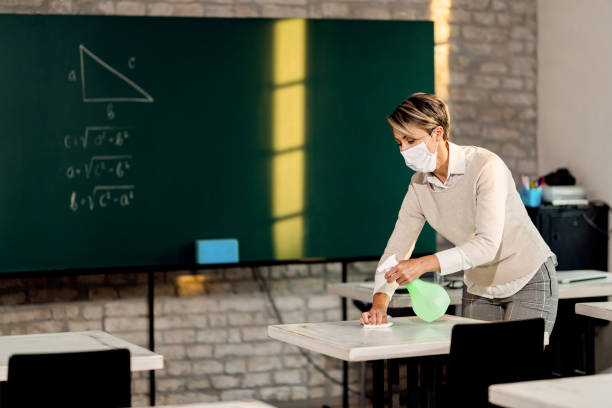Schools are places where it is necessary to intensify hygienic work, being in these times a much more important task due to the growth of contagion among minors.
The presence of numerous children requires extreme care so that the facilities have an optimal state of health, therefore, cleaning in schools is another service to be highlighted in our blog.
Disinfection and cleaning in schools
Due to the large number of students who pass through the premises of a school, it is essential to carry out a demanding protocol. As a cleaning company with extensive experience in the sanitation of this type of premises, we know that cleaning in schools and disinfection tasks are essential to prevent the spread of diseases and minimize risks.
Important areas to disinfect in schools
On the other hand, it is vital to increase cleanliness in bathrooms and changing rooms, as well as in dining rooms and kitchens. These spaces are where microorganisms harmful to health are most likely to accumulate due to the activities carried out in them.
Other surfaces where operators have to act more aggressively are desks, doors, and drinking fountains, to give a few examples.
These elements, due to their daily use, can become sources of pathogens and bacteria, since many hands pass through them on a daily basis.
It is very important to select the most suitable products to carry out the disinfection of the different areas of the schools. Precisely because it is an environment surrounded by children, it is important that the chemicals used in cleaning are the least caustic and dangerous to their health.
Classroom in a school
Important concepts of school cleaning
-
Cleaning: It is eliminating impurities and society from surfaces and different objects that may be in a school or in a place. It is usually based on basic cleaning products to remove dirt that is in sight. This process does not eliminate germs, but it reduces the number that may be present.
-
Disinfection: It is the cleaning process that uses a series of chemical products to kill germs from all kinds of surfaces and places. This process is supposed to be done to eliminate germs that may be in schools and nurseries to reduce the risk of spreading any contagious disease.
-
Sanitization: It is the third step and comprises reducing the number of germs through the cleaning of schools, nurseries, or universities. Through the application of chemical substances and heat, we eliminated the microorganisms present on the different surfaces. A specialized company always carries it out and the Ministry of Health approved a series of regulations and requirements that must be carried out in public and private places where a group of people interacts daily.
Essential processes in school cleaning
Clean and disinfect classrooms and rooms thoroughly
In schools and nurseries, there are dozens of objects that are touched by children frequently and they need to be cleaned and disinfected at a minimum frequency. We refer to tables, computer keyboards, toys, faucets, bathrooms, or desks. With nurseries, it may soil some of these items with bodily fluids. For cleaning these products, we should always use gloves for personal protection.
Increase the level of cleaning in key periods
The beginning of spring or the beginning of winter are usually two key times of the year when diseases spread more quickly because of changes in the weather. During the months of November and December, we usually carry prevention campaigns out to avoid colds, the flu, or other related viruses. Schools are not normally closed for special cleaning, but cleaning needs to be intensified. It is necessary to carry out the cleaning process to remove germs and the disinfection process to kill them.
Ventilate classrooms in schools and nurseries
Before carrying out any cleaning, disinfection, or sanitation process, proper ventilation of the classrooms and common rooms to be cleaned must be carried out.
Carpet Cleaning
In some nurseries, it is very common to have rugs to cover the floors of the classrooms. We recommend that rugs be stripped down and cleaned regularly because they collect a lot of dust. It is important to take them to a specialized cleaning shop.
Reduce dust mite allergies
Mites are common inhabitants of any room and increase in times of high temperatures or places with a high level of humidity. To do this, it is important to thoroughly clean schools and prevent the spread of dust mite allergies, which have increased so much in recent years. To do this, dust must be removed daily, and the rooms ventilated to renew the air. Mites can be cleaned with a conventional vacuum cleaner, although many school cleaning companies or office cleaning companies have specialized machinery for this.
How to clean in schools
In this way, the risk of negative side effects on the health of minors, who are more susceptible to allergic reactions to more abrasive products, is avoided.
To carry out this type of work, we can use some techniques that we discuss below:
-
We recommend it to use microfiber cloths and cloths.
-
Besides the disinfection operation, it is essential to carry out a correct aspiration to eliminate the remains of dust.
-
Regarding floor scrubbing, we can do manually it or with a scrubbing machine.
-
It is important to ventilate the different rooms.
-
Removing the waste stored in the bins daily is vital for a school to be in good health conditions.
SCS Group Integrated Services offers sanitation services in schools exhaustively and effectively. We know that the hygiene and disinfection of schools are vital to guarantee the good health of students.
If you need a cleaning company in Sydney, put yourself in the hands of SCS Group Integrated Services, made up of professionals with over 15 years of experience.

